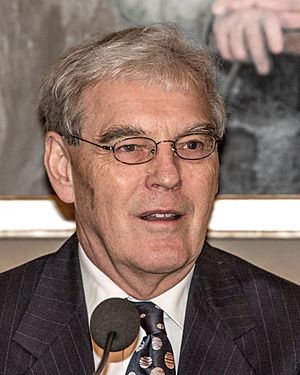Richard Henderson facts for kids
Quick facts for kids
Richard Henderson
|
|
|---|---|

Henderson during Nobel Prize press conference in Stockholm in 2017
|
|
| Born | 19 July 1945 Edinburgh, Scotland
|
| Alma mater | |
| Known for | Cryo-electron microscopy |
| Awards |
|
| Scientific career | |
| Fields |
|
| Institutions | |
| Thesis | X-Ray Analysis of α-chymotrysin: Substrate and Inhibitor Binding (1970) |
| Doctoral advisor | David Mervyn Blow |
Richard Henderson (born 19 July 1945) is a Scottish scientist. He studies the tiny parts that make up living things. He is known for his work with electron microscopes. These special microscopes help us see very small biological molecules.
In 2017, he won the Nobel Prize in Chemistry. He shared this big award with two other scientists, Jacques Dubochet and Joachim Frank. They were all honored for making electron microscopy much better.
Contents
Seeing the Smallest Parts of Life
Richard Henderson is a pioneer in a field called electron microscopy. This means he was one of the first people to use electron microscopes in new ways. He used them to study biological molecules. These are the tiny building blocks inside all living things.
What is Electron Microscopy?
Imagine trying to see something too small for a regular microscope. That's where electron microscopes come in! Instead of light, they use a beam of electrons to "see" objects. This lets scientists look at things like proteins and DNA in amazing detail.
Henderson helped make a method called cryo-electron microscopy (cryo-EM) much better. "Cryo" means very cold. In this method, samples are frozen very quickly. This keeps their natural shape. Then, scientists can take many pictures from different angles. These pictures are combined to create a 3D model. It's like taking many photos of a building from all sides to make a full model.
Discovering Bacteriorhodopsin's Structure
One of Henderson's most important discoveries was figuring out the structure of a molecule called bacteriorhodopsin. This molecule is found in some types of bacteria.
Bacteriorhodopsin is special because it can capture energy from light. It uses this energy to move tiny particles called protons out of the bacterial cell. This process helps the bacteria get energy.
Henderson's work showed the atomic model of this molecule. It was only the second time scientists had seen the detailed structure of a membrane protein. Membrane proteins are important because they are found in the outer layer of cells. They help cells communicate and move things in and out.
How His Work Helps Us
The methods Henderson developed are still used today. They help scientists understand many important proteins. For example, his techniques have helped solve the structures of several G protein–coupled receptors (GPCRs).
GPCRs are a large family of proteins. They act like tiny sensors on the outside of cells. They detect different molecules, like hormones or smells. When a GPCR senses something, it sends a signal inside the cell. This signal tells the cell how to respond.
Understanding these structures helps scientists in many ways. It can lead to new medicines. These medicines could target specific proteins to treat diseases.
His Career and Awards
Richard Henderson has worked at the Medical Research Council Laboratory of Molecular Biology (MRC LMB) in Cambridge, England, for a long time. He started there in 1973. He was even the director of the lab from 1996 to 2006.
His amazing work has earned him many awards. The biggest one was the Nobel Prize in Chemistry in 2017. He received it for his important contributions to cryo-electron microscopy. This method has changed how scientists study biological molecules.

